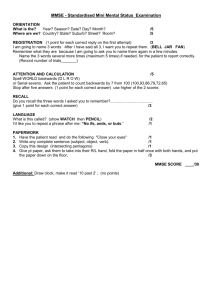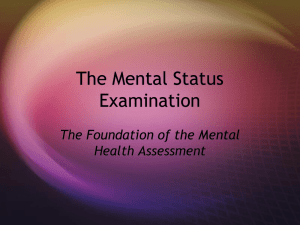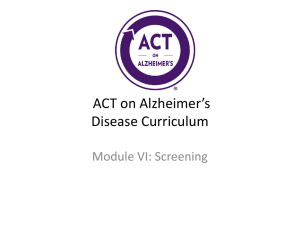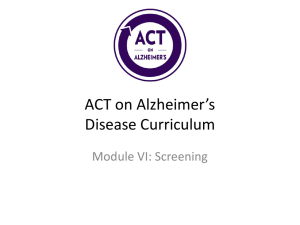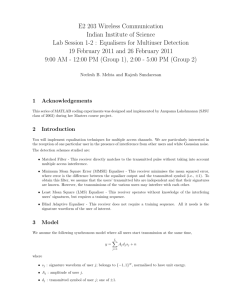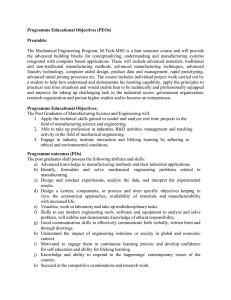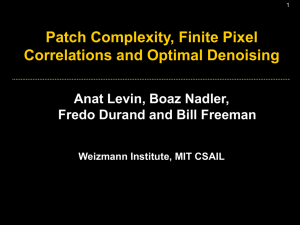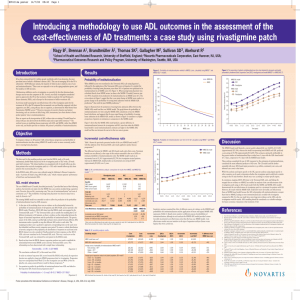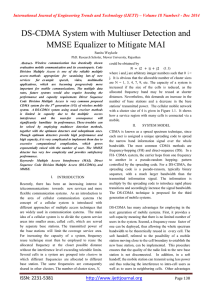Mini-Mental State Examination - 2nd Edition (MMSE-2)
advertisement
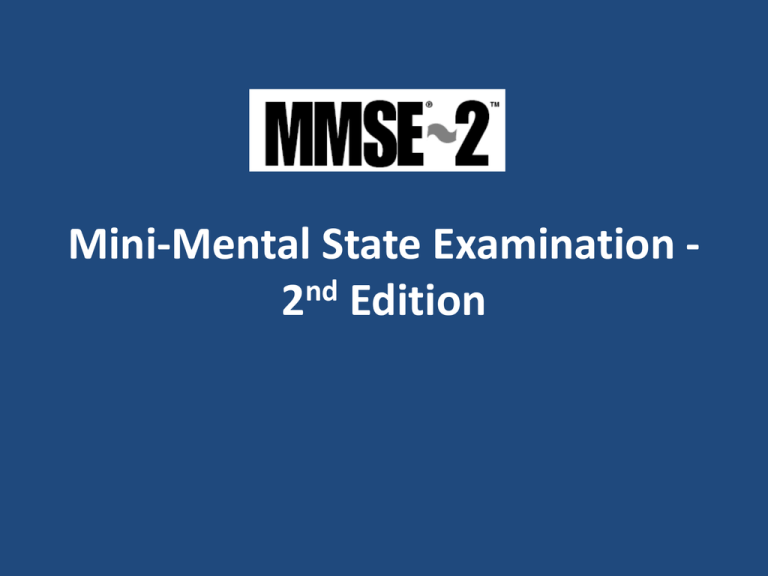
Mini-Mental State Examination 2nd Edition Overview • Original MMSE is one of the most widely used brief screening instruments for cognitive impairment • Has been used in a variety of settings, including screening individual patients, tracking progress over time, screening for large populations, and clinical trials Goals for the Revision 1. Revise some of the original items to better standardize its administrations, particularly for translations 2. Provide an even briefer version that could be used for rapid assessment 3. Provide a slightly longer version that would be more sensitive to subcortical dementia and that would not have a ceiling effect 4. Develop equivalent alternate forms to decrease practice effects in serial administration Goal #1: Revise Original Items • The MMSE-2 Standard Version (MMSE-2:SV) maintains the same structure and scoring as the original MMSE • Changes were made to improve problematic items and to better standardize administration in other languages (e.g., penny, no if, ands, or buts) MMSE-2: Standard Version Task Description Identical task on Original MMSE Revision on MMSE-2:SV Registration & Recall Ability to repeat and retain three unrelated words, and then recall after a short intervention task Words have been made slightly more difficult and easier to translate Orientation to Time Identify current year, season, month, day of the week, and date X Orientation to Place Identify state, county, city/town, building, and floor currently in X Attention & Calculation (Serial 7s) Count backwards by 7s X Naming Ask to identify body parts when pointed to by examiner Change from “watch” and “pencil” to body parts allows for translation and no use of external materials Repetition Required to repeat a sentence that contains words not often said together Revised to include a sentence that is easier to translate and difficulty slightly decreased Comprehension Understand and carry out a three-stage verbal command Removed the reliance on motor responses. Reading Read and follow instructions X Writing Asked to write a sentence X Drawing Asked to copy intersecting pentagons X No longer can use WORLD spelled backwards as alternate task Equivalency Between the MMSE and MMSE-2:SV • Like the MMSE, the MMSE-2:SV has a raw score range of 0-30 • The generalizability coefficient (n = 411) between the MMSE and the MMSE-2:SV total raw score was .97 • Therefore it is possible to switch from MMSE to the MMSE-2:SV without compromising longitudinal data and without any change in the normal range of scores Goal #2: Develop Briefer Version • Can be used for quick cognitive screener, specifically when an individual has not been referred for specific cognitive impairment • Composed of Registration/Recall, Orientation to Time, and Orientation to Place • Raw score ranges from 0-16 points • Tasks were selected based on literature review, use in the MMSE, and their sensitivity and specificity to detect dementia MMSE-2: Brief Version Goal #3: Develop Expanded Version • Consists of all of the items on the MMSE-2:SV plus two new tasks: – Story Memory: An immediate recall of a brief story – Processing Speed: A symbol-digit coding task MMSE-2: Expanded Version • Improves the clinical utility of the MMSE by: – Extending the test’s ceiling – Increasing the range of raw scores (0-90) – Increasing the sensitivity for individuals with less severe cognitive impairment (subcortical dementia, MCI) Goal #4: Develop Equivalent Alternate Forms • Two forms (Blue and Red) were developed for each of the 3 versions of the MMSE-2 • Based on the results of the equating study, the accuracy of the equating process was confirmed Equating: MMSE & MMSE-2:SV Administration Issues • 18 years and older • Relatively easy to administer, typically one training session is sufficient • Test Materials: – – – – User’s Manual Pocket Norms Guide Scoring Templates for Processing Speed Administration Forms : • MMSE-2:BV Blue and Red Form • MMSE-2:SV Blue and Red Form • MMSE-2:EV Blue and Red Form Overview of Administration Forms Task MMSE MMSE-2:BV MMSE-2:SV MMSE-2:EV Registration & Recall X X X X Orientation to Time X X X X Orientation to Place X X X X Attention & Calculation (Serial 7s) X X X Naming X X X Repetition X X X Comprehension X X X Reading X X X Writing X X X Drawing X X X Story Memory X Processing Speed X Determining Which Version is Appropriate • MMSE-2:BV – Adequate for screening large populations; screening individuals in practice who have not been referred because of cognitive complaints • MMSE-2:SV – Used first if referred because of complaint of cognitive decline or if patient indicates memory is not as good as it use to be; depending on results may want to supplement with MMSE-2:EV • MMSE-2:EV – Same as above + well educated (ceiling effect); suspected subcortical dementia Scoring • Mean raw total scores are presented by age and education level • T scores are also presented by age and education level • Pocket Guide • Reliable Change Scores Reliable Change Scores • Reliable change refers to the extent to which the change in test performance shown by an individual falls beyond the range that can be attributed to practice effects or to measurement variability that is inherent to the instrument itself • The approach used here is a method developed by Iverson (2001) Interpretation • A cut score of 22/23 is typically used with the original MMSE • Because the MMSE-2:SV is equivalent to the MMSE, the same cut score is suggested • The authors have not provided specific recommendations for the new forms, however ranges of raw score cut scores are provided for the dementia, AD, and subcortical samples by form Example of Cutoff Table Development • Task Development – 5 additional tasks were tested • Bias Panel – assessed potential bias and offensiveness to protected groups • Expert Review: – 2 neuropsychologist, 1 geriatric psychologist, 1 geriatric psychiatrist – Aided in selection of tasks, provided feedback on content, and assisted with refining items and instructions for the pilot and standardization versions Pilot Testing Standardization Sample n = 1,531 healthy controls Cognitively Impaired Samples Effects of Age and Education Development of the Norms • Because of the importance of age and education on MMSE-2 scores norms were developed for several different age and education ranges • Two resources for age and education adjustments are provided: 1. Means and standard deviations of total raw scores by age and education groups 2. Age- and education-adjusted T scores (continuous norming method) Reliability: Internal Consistency Reliability: Test Retest Reliability: Interrater Validity • Content Validity – similar items on other tests (e.g., Serial 7s similar to attention and concentration task on WMS-III) • Intercorrelations among task and total scores (presented for both the normative and clinical samples) • Diagnostic Validity: Prior work on the MMSE using 22/23 or 23/24 Validity • Convergent Validity: – – – – – – – – – WMS-III subtests Category Naming Test COWA BNT TMT WAIS-R subtests JOLO HVLT-R Stroop Color and Word Test
